Applications of Virtual and Augmented Reality Technology to Teaching and Research in Construction and Its Graphic Expression
Abstract
1. Introduction
2. Hypothesis
3. Objectives
4. Materials and Methods
4.1. Organization of the Actions
4.2. Actions Developed
- (1)
- Search of documentation and information of different constructive encounters. In this case each student will look for a real building or civil construction and will analyze the constructive solutions of the same (Figure 4).
- (2)
- Each student then replicates the detail with a three-dimensional modeling using the SketchUp tool, which has been previously explained to them with basic training.
- (3)
- Virtualize the model and disseminate it.
- (1)
- Capturing data by means of photographs with a camera (Table 1).
- (2)
- Digitization by photogrammetry with Agisoft Metashape Professional 1.7 software.
- a.
- Image alignment;
- b.
- Generation of sparse point cloud;
- c.
- Dense point cloud generation;
- d.
- Mesh and texture generation.
- (3)
- Export of the model in OBJ format, and dissemination of the model through the Sketchfab platform.
5. Results
5.1. Results Obtained from Action 1: Generation of Digital Teaching Resources to Promote Online and Autonomous Learning
5.2. Results Obtained from Action 2: Learning through Digitization and Replication of the Non-Visible Built Reality
- (1)
- A digital model with free access, which promotes and contributes to the creation of the catalogue of digital models of heritage elements (Figure 11).
- (2)
- From this model, each person can print the 3D models (Figure 12).
5.3. Results Obtained from Action 3: Testing the Method for Research in Other Related Areas
6. Discussion
- –
- Regarding cost, although a priori with reduced and economic resources we could carry out small activities, carrying out a complete implementation in the educational system can become costly, both in terms of hardware and software. In addition, the constant evolution and updating of this technology can make its widespread adoption in educational institutions difficult.
- –
- Another factor to consider is student access to virtual reality devices, which can generate inequalities in access to educational opportunities. Schools seeking to implement this technology must ensure that all students have equal opportunity to participate.
- –
- To effectively use virtual reality in the classroom, teachers must receive appropriate training and professional development. Many educators may be unfamiliar with the technology and may require additional time and support to effectively integrate it into their teaching. This is why the implementation of this system should be introduced as an additional and supportive tool to traditional educational systems.
- –
- Limited educational experience. Although virtual reality can provide immersive and visually stunning experiences, there are still limitations in terms of educational content. Creating quality and relevant content for virtual reality requires additional time and resources. In addition, some subject areas may be difficult to teach exclusively through virtual reality, limiting its applicability to certain educational topics. There is a lack of standardization and specific applications to be used in the educational system, but little by little progress is being made and initiatives are emerging every day that pave the way towards an education and culture accessible from anywhere in the world.
7. Conclusions
- –
- When generating the educational content in each of the workshops, it has been a very fruitful work, since these resources represent the beginning of the creation of a library to which other initiatives carried out by other universities can be added in successive years. With these types of activities, we are working in a transversal way on the acquisition of digital skills while promoting the student’s spatial vision and the construction process of buildings. With these activities we have seen an improvement in the educational performance of students, their motivation and involvement are greater because they are curious about these new procedures.
- –
- With respect to the technological limitations, it is true that if these initiatives were implemented it would require a large investment; however, for the development of this project we have used the university’s own hardware and software, and with these few resources we have achieved very good results. In addition, when making small didactic resources, such as small construction details, small-scale architectural pieces, or even for urban elements, the scale has been adjusted and divided into small fragments, thus we have solved the disadvantage of having to use very powerful technological devices. These small resources can be visualized with AR from the students’ own cell phones.
- –
- On the other hand, the research and teaching team that has carried out this project already had previous knowledge of this work method, and it is true that this required self-training and self-research for many years. However, if this is introduced little by little in our system of higher education, the time will come when these tools will be of daily use and management.
Author Contributions
Funding
Institutional Review Board Statement
Informed Consent Statement
Data Availability Statement
Acknowledgments
Conflicts of Interest
References
- Yan, Z.; Lv, Z. The Influence of Immersive Virtual Reality Systems on Online Social Application. Appl. Sci. 2020, 10, 5058. [Google Scholar] [CrossRef]
- Hamilton, D.; McKechnie, J.; Edgerton, E.; Wilson, C. Immersive virtual reality as a pedagogical tool in education: A systematic literature review of quantitative learning outcomes and experimental design. J. Comput. Educ. 2020, 8, 1–32. [Google Scholar] [CrossRef]
- Freina, L.; Ott, M. A literature review on immersive virtual reality in education: State of the art and perspectives. In Proceedings of the International Scientific Conference eLearning and Software for Education (eLSE), Bucharest, Romania, 23–24 April 2015; pp. 133–141. [Google Scholar] [CrossRef]
- Sacks, R.; Perlman, A.; Barak, R. Construction safety training using immersive virtual reality. Constr. Manag. Econ. 2013, 31, 1005–1017. [Google Scholar] [CrossRef]
- Araiza-Alba, P.; Keane, T.; Chen, W.S.; Kaufman, J. Immersive virtual reality as a tool to learn problem-solving skills. Comput. Educ. 2021, 164, 104121. [Google Scholar] [CrossRef]
- Zuo, T.; Jiang, J.; Spek, E.V.D.; Birk, M.; Hu, J. Situating Learning in AR Fantasy, Design Considerations for AR Game-Based Learning for Children. Electronics 2022, 11, 2331. [Google Scholar] [CrossRef]
- Silva Quiroz, J.M.C.D. A proposed model for introducing active methodologies in higher education. Innovación Educ. 2017, 17, 15. [Google Scholar]
- Rehman, M.S.U.; Abouelkhier, N.; Shafiq, M.T. Exploring the Effectiveness of Immersive Virtual Reality for Project Scheduling in Construction Education. Buildings 2023, 13, 1123. [Google Scholar] [CrossRef]
- Parrinello, S.; Dell’amico, A. Experience of Documentation for the Accessibility of Widespread Cultural Heritage. Heritage 2019, 2, 1032–1044. [Google Scholar] [CrossRef]
- Parrinello, S.; Morandotti, M.; Valenti, G.; Piveta, M.; Basso, A.; Inzerillo, A.; Lo Turco, M.; Picchio, F.; Santagati, C. Digital & Documentation: Databases and Models for the Enhancement of Heritage; Pavia University Press: Pavia, Italy, 2019; Volume 1. [Google Scholar]
- Alizadehsalehi, S.; Hadavi, A.; Huang, J. Virtual Reality for Design and Construction Education Environment. In Civil and Environmental Engineering; American Society of Civil Engineers (ASCE): Reston, VA, USA, 2019; Available online: https://ascelibrary.org/doi/abs/10.1061/9780784482261.023 (accessed on 18 May 2023).
- Ghanem, S.Y. Implementing virtual reality—Building information modeling in the construction management curriculum. J. Inf. Technol. Constr. 2022, 27, 48–69. [Google Scholar] [CrossRef]
- Häfner, P.; Häfner, V.; Ovtcharova, J. Teaching Methodology for Virtual Reality Practical Course in Engineering Education. Procedia Comput. Sci. 2013, 25, 251–260. [Google Scholar] [CrossRef]
- Kim, K.; Alshair, M.; Holtkamp, B.; Yun, C.; Khalafi, S.; Song, L.; Suh, M.J. Using Immersive Augmented Reality to Assess the Effectiveness of Construction Safety Training. J. Constr. Eng. Proj. Manag. 2019, 9, 16–33. [Google Scholar] [CrossRef]
- Whisker, V.; Yerrapathruni, S.; Messner, J.; Baratta, A. Using Virtual Reality to Improve Construction Engineering Education. In Proceedings of the 2003 Annual Conference, Nashville, TN, USA, 22–25 June 2020; pp. 8.1266.1–8.1266.9. [Google Scholar]
- Cruz Franco, P.A.; de la Plata, A.R.M. Tad3lab Models Library. 2021. Available online: https://sketchfab.com/TAD3LAB/models (accessed on 6 September 2021).
- Amato, F.; Moscato, V.; Picariello, A.; Sperli, G. KIRA: A System for Knowledge-Based Access to Multimedia Art Collections. In Proceedings of 2017 IEEE 11th International Conference on Semantic Computing (ICSC), San Diego, CA, USA, 30 January–1 February 2017; pp. 338–343. [Google Scholar]
- Barrado-Timón, D.A.; Hidalgo-Giralt, C. The Historic City, Its Transmission and Perception via Augmented Reality and Virtual Reality and the Use of the Past as a Resource for the Present: A New Era for Urban Cultural Heritage and Tourism? Sustainability 2019, 11, 2835. [Google Scholar] [CrossRef]
- Obradović, M.; Vasiljević, I.; Đurić, I.; Kićanović, J.; Stojaković, V.; Obradović, R. Virtual Reality Models Based on Photogrammetric Surveys—A Case Study of the Iconostasis of the Serbian Orthodox Cathedral Church of Saint Nicholas in Sremski Karlovci (Serbia). Appl. Sci. 2020, 10, 2743. [Google Scholar] [CrossRef]
- Ramos Sánchez, J.A. Utilización de la Metodología BIM en la gestión del Patrimonio Arqueológico. Caso de Estudio el Recinto Arqueológico de los Llamados Columbarios de Merida, in Construcción; Universidad de Extremadura: Caceres, Spain, 2021; p. 179. [Google Scholar]
- Fahim, S.; Maqsood, A.; Das, G.; Ahmed, N.; Saquib, S.; Lal, A.; Khan, A.A.G.; Alam, M.K. Augmented Reality and Virtual Reality in Dentistry: Highlights from the Current Research. Appl. Sci. 2022, 12, 3719. [Google Scholar] [CrossRef]
- Pregowska, A.; Osial, M.; Dolega-Dolegowski, D.; Kolecki, R.; Proniewska, K. Information and Communication Technologies Combined with Mixed Reality as Supporting Tools in Medical Education. Electronics 2022, 11, 3778. [Google Scholar] [CrossRef]
- Cruz Franco, P.A.; de la Plata, A.R.M.; Cortés Pérez, J.P. Veinte Siglos de Patrimonio de Extremadura en Ocho Puentes; Documentación Digital de las Obras Públicas: Extremadura, Spain, 2018; Volume 1, p. 208. [Google Scholar]
- Muñoz-Guevara, E.; Velázquez-García, G.; Barragán-López, J.F. Análisis sobre la evolución tecnológica hacia la Educación 4.0 y la virtualización de la Educación Superior. Transdigital 2021, 2, 1–14. [Google Scholar] [CrossRef]
- Castro, J.P. Educación emprendedora y metodologías activas para su fomento. Rev. Electrónica Interuniv. Form. Profr. 2017, 20, 33–48. [Google Scholar] [CrossRef]
- Zabalza Beraza, M.A. El Trabajo por Competencias en la Enseñanza Universitaria. Jornades D’innovació Docent De La UAB. 2007, pp. 1–27. Available online: https://dialnet.unirioja.es/servlet/articulo?codigo=2858252 (accessed on 18 May 2023).
- Burgos-Leiva, C.A.; Rementeria-Piñones, J.A.; Espinoza-Oyarzún, J.C.; Rodríguez-García, A.B. Aprendizaje basado en proyectos aplicados en la asignatura de materiales de construcción. Form. Univ. 2021, 14, 105–112. [Google Scholar] [CrossRef]
- Romero-Saritama, J.; Simaluiza, R. Aprendizaje Basado en Productos: Una propuesta metodológica de enseñanza activa en la educación universitaria. Aprendizaje, Innovación y Cooperación como impulsores del cambio metodológico. In Proceedings of the V Congreso Internacional sobre Aprendizaje, Innovación y Cooperación, CINAIC, Madrid, Spain, 9–11 October 2019. [Google Scholar] [CrossRef]
- Barrett, T. Understanding Problem-Based Learning. University of Tampere: Tampere, Finland, 2006; p. 25.
- Cotrina, A.R.R. Eficacia del Programa de Enseñanza Activa en las Estrategias de Aprendizaje de los Estudiantes Universitarios. Gac. Cientíca 2015, 161, 154–158. [Google Scholar]
- Franco, P.A.C.; de la Plata, A.R.M.; Franco, J.C. From the Point Cloud to BIM Methodology for the Ideal Reconstruction of a Lost Bastion of the Cáceres Wall. Appl. Sci. 2020, 10, 6609. [Google Scholar] [CrossRef]
- Franco, P.A.C.; de la Plata, A.R.M.; Bernal, E.G. Protocols for the Graphic and Constructive Diffusion of Digital Twins of the Architectural Heritage That Guarantee Universal Accessibility through AR and VR. Appl. Sci. 2022, 12, 8785. [Google Scholar] [CrossRef]
- Gómez Bernal, E.; Cruz Franco, P.A.; de la Plata, A.R.M. Drones in architecture research: Methodological application of the use of drones for the accessible intervention in a roman house in the Alcazaba of Mérida (Spain). In Proceedings of the D-SITE. Drines-Systems of Information on Cultural Heritage, Pavia, Italy, 24–26 June 2020. [Google Scholar]
- Cruz Franco, P.; Rueda Márquez de la Plata, A.; Pérez Sendín, M. Investigating a Workflow for Obtaining Physical Models from Digital Twins Obtained through Photogrammetry and TLS: New Ways for a Sustainable Dissemination of Heritage. Appl. Sciences. 2023, 13, 1057. [Google Scholar] [CrossRef]
- Sánchez, J.A.R.; Franco, P.A.C.; de la Plata, A.R.M. Achieving Universal Accessibility through Remote Virtualization and Digitization of Complex Archaeological Features: A Graphic and Constructive Study of the Columbarios of Merida. Remote Sens. 2022, 14, 3319. [Google Scholar] [CrossRef]
- Rodriguez Sánchez, C. Levantamiento y Propuesta de Accesibilidad en el Jardín Histórico de la Arguijuela de Arriba (Cáceres); Universidad de Extremadura: Caceres, Spain, 2021. [Google Scholar]
- Franco, P.A.C.; de la Plata, A.R.M.; Franco, J.C.; Rubio, J.A.R. A lost Fragment and Gate of the Almohad Wall of the World Heritage City of Cáceres, Spain. IOP Conf. Series: Mater. Sci. Eng. 2017, 245, 052051. [Google Scholar] [CrossRef]
- Michaelsen, L.; Davidson, N.; Major, C. Team-Based Learning Practices and Principles in Comparison with Cooperative Learning and Problem-Based Learning. Teach. High. Educ. 2014, 25, 57. [Google Scholar]
- Sáez, I.; Martinez, I.; Martinez, b.; Gezuraga, M. El Aprendizaje-Servicio en la innovación universitaria. Una experiencia realizada en la formación de educadoras y educadores sociales. Rev. Int. Educ. Justicia Soc. 2013, 2, 195–216. [Google Scholar]
- Rovira, J.M.P.; Casares, M.G.; García, M.J.M.; Serrano, L.R. Aprendizaje-servicio y Educación para la Ciudadanía. Rev. Educ. 2011, 1, 45–67. [Google Scholar]
- Jouannet, C.; Salas, M.H.; Contreras, M.A. Modelo de implementación de Aprendizaje Servicio (A+S) en la UC: Una experiencia que impacta positivamente en la formación profesional integral. Calid. Educ. 2013, 39, 197–212. [Google Scholar] [CrossRef]
- Fernández-Arias, P.; Antón-Sancho, Á.; Sánchez-Jiménez, M.; Vergara, D. Statistical Analysis of Professors’ Assessment Regarding the Didactic Use of Virtual Reality: Engineering vs. Health. Electronics 2023, 12, 1366. [Google Scholar] [CrossRef]
- Cruz Franco, J.; Cruz Franco, P.A.; Márquez de la Plata, A.R.; Rubio, J.A.R.; Rueda Muñoz de San Pedro, J.M. Evolución histórica de la muralla de Cáceres y nuevos descubrimientos. El postigo de San Miguel, un lienzo perdido de la cerca almohade. Rev. Estud. Extrem. 2016, 72, 1869–1910. [Google Scholar]
- Han, J.; Liu, G.; Gao, Y. Learners in the Metaverse: A Systematic Review on the Use of Roblox in Learning. Educ. Sci. 2023, 13, 296. [Google Scholar] [CrossRef]
- Xenos, M. The Future of Virtual Classroom: Using Existing Features to Move Beyond Traditional Classroom Limitations. In Interactive Mobile Communication Technologies and Learning; Springer International Publishing: New York, NY, USA, 2018; pp. 944–951. [Google Scholar] [CrossRef]
- Afzal, M.; Shafiq, M.T.; Al Jassmi, H. Improving construction safety with virtual-design construction technologies—A review. J. Inf. Technol. Constr. 2021, 26, 319–340. [Google Scholar] [CrossRef]
- Afzal, M.; Shafiq, M.T. Evaluating 4D-BIM and VR for Effective Safety Communication and Training: A Case Study of Multilingual Construction Job-Site Crew. Buildings 2021, 11, 319. [Google Scholar] [CrossRef]
- Bonifaz, E.; Molina, F. Realidad Aumentada y su Aporte al Patrimonio Cultural. 2015. Available online: https://www.researchgate.net/publication/285586100 (accessed on 18 May 2023).


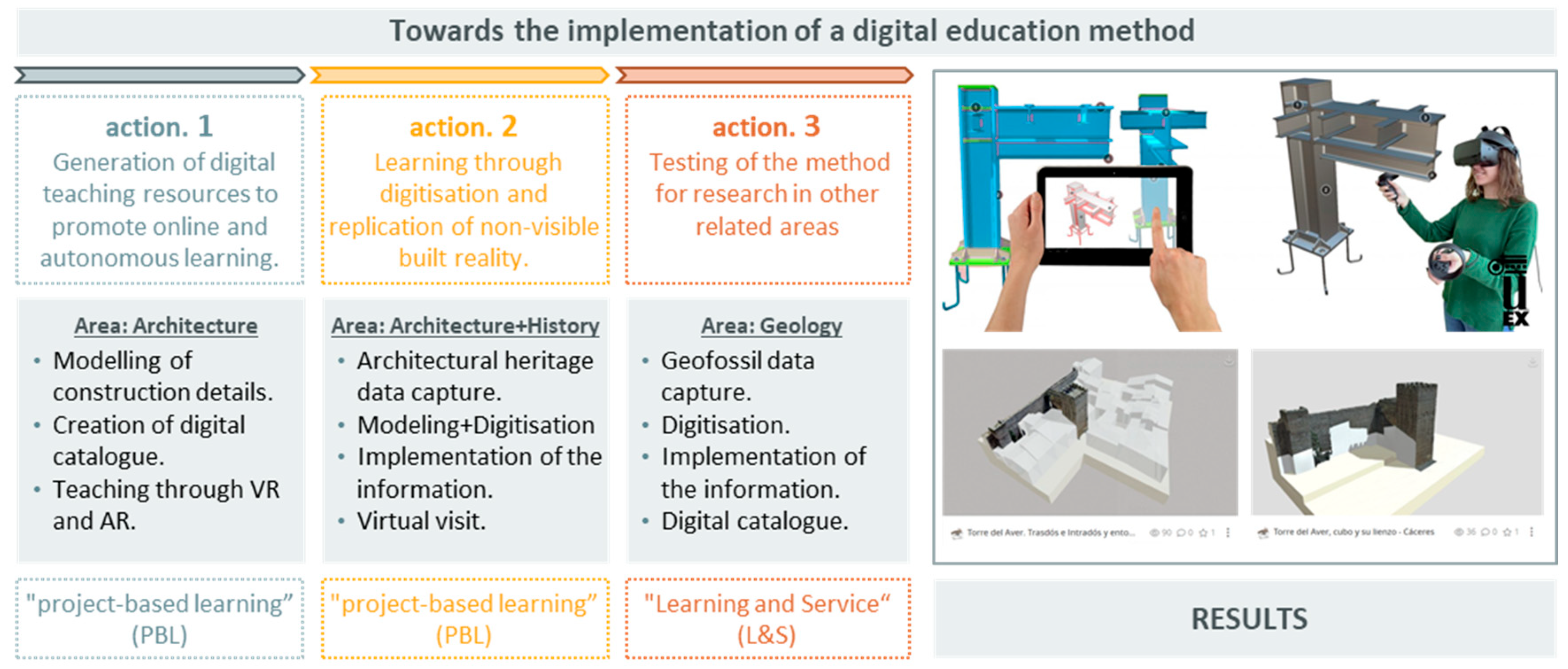
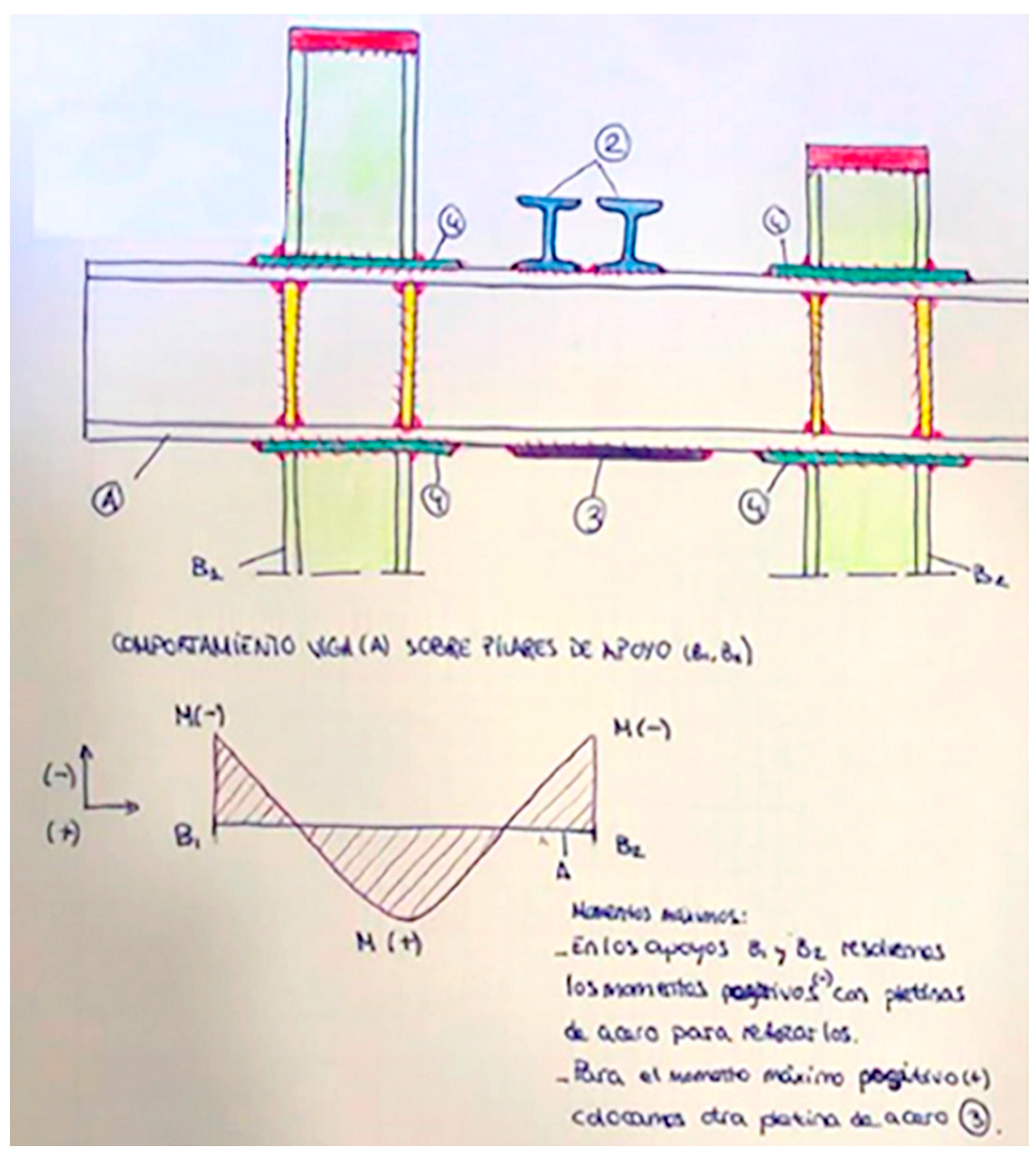
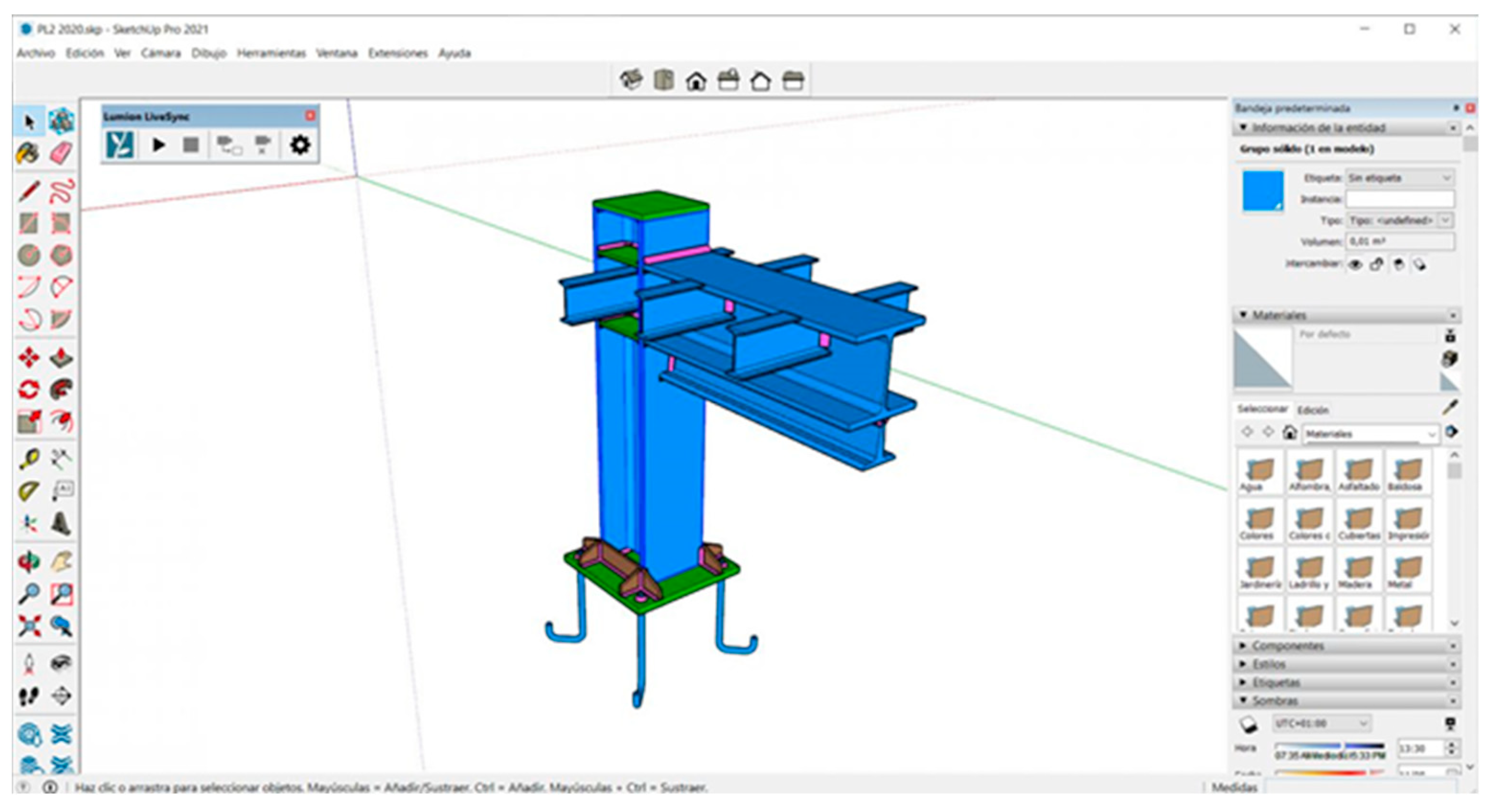

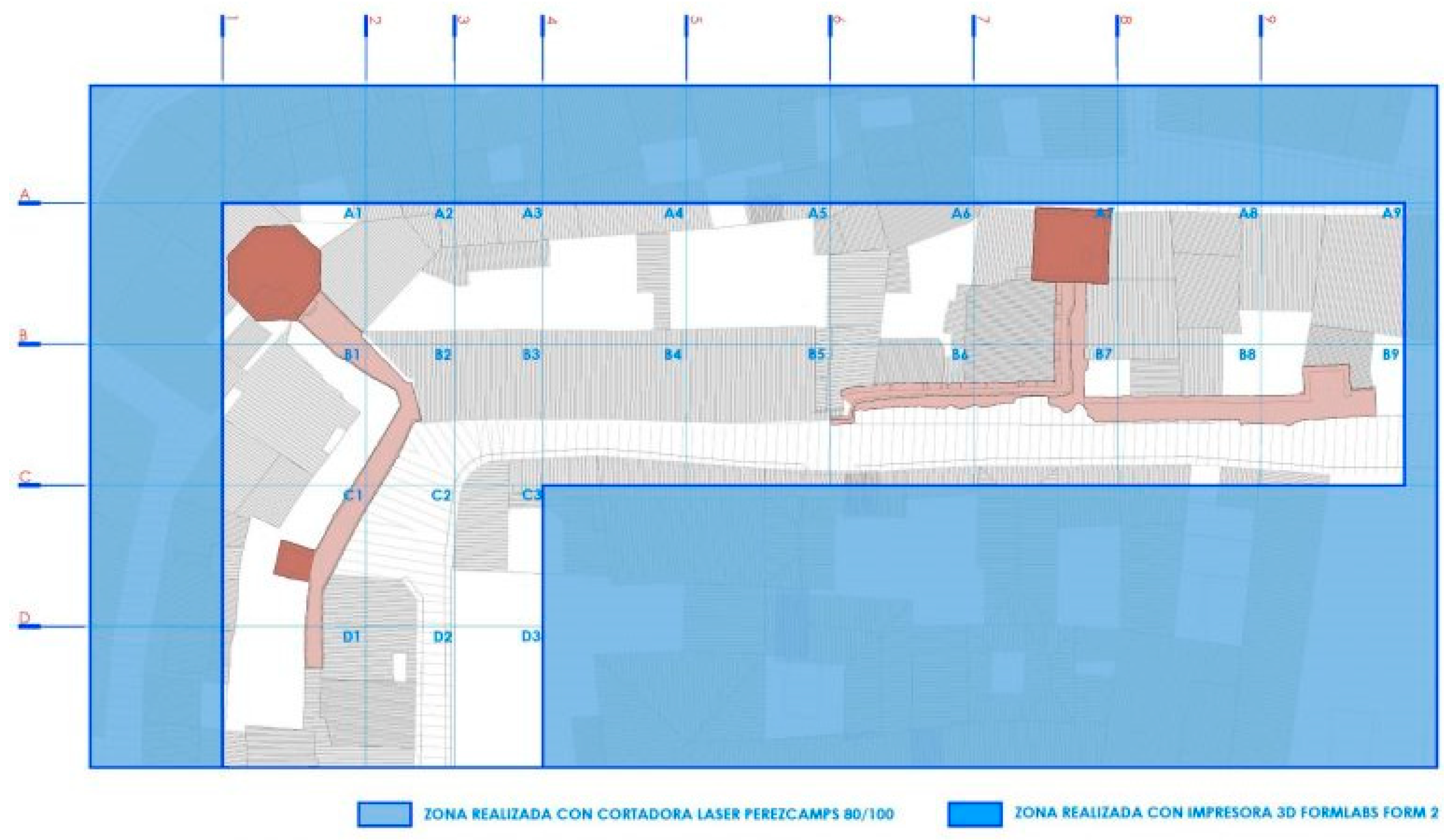
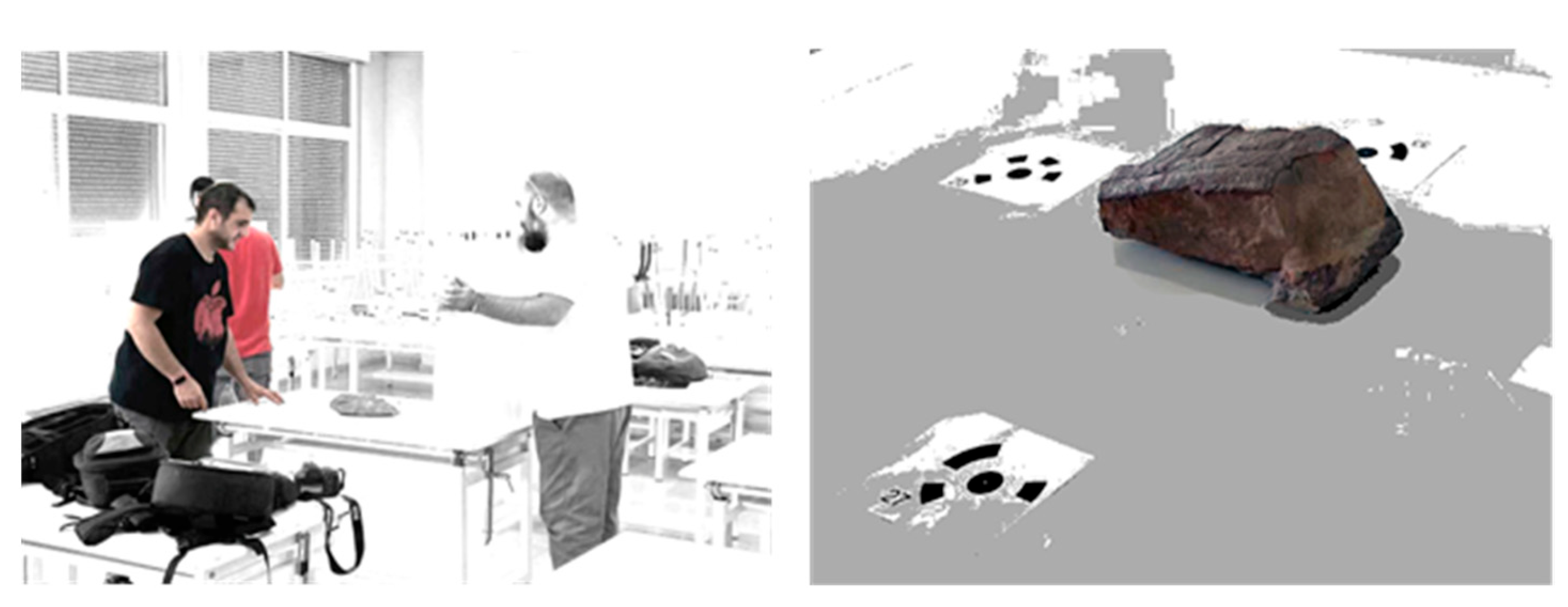
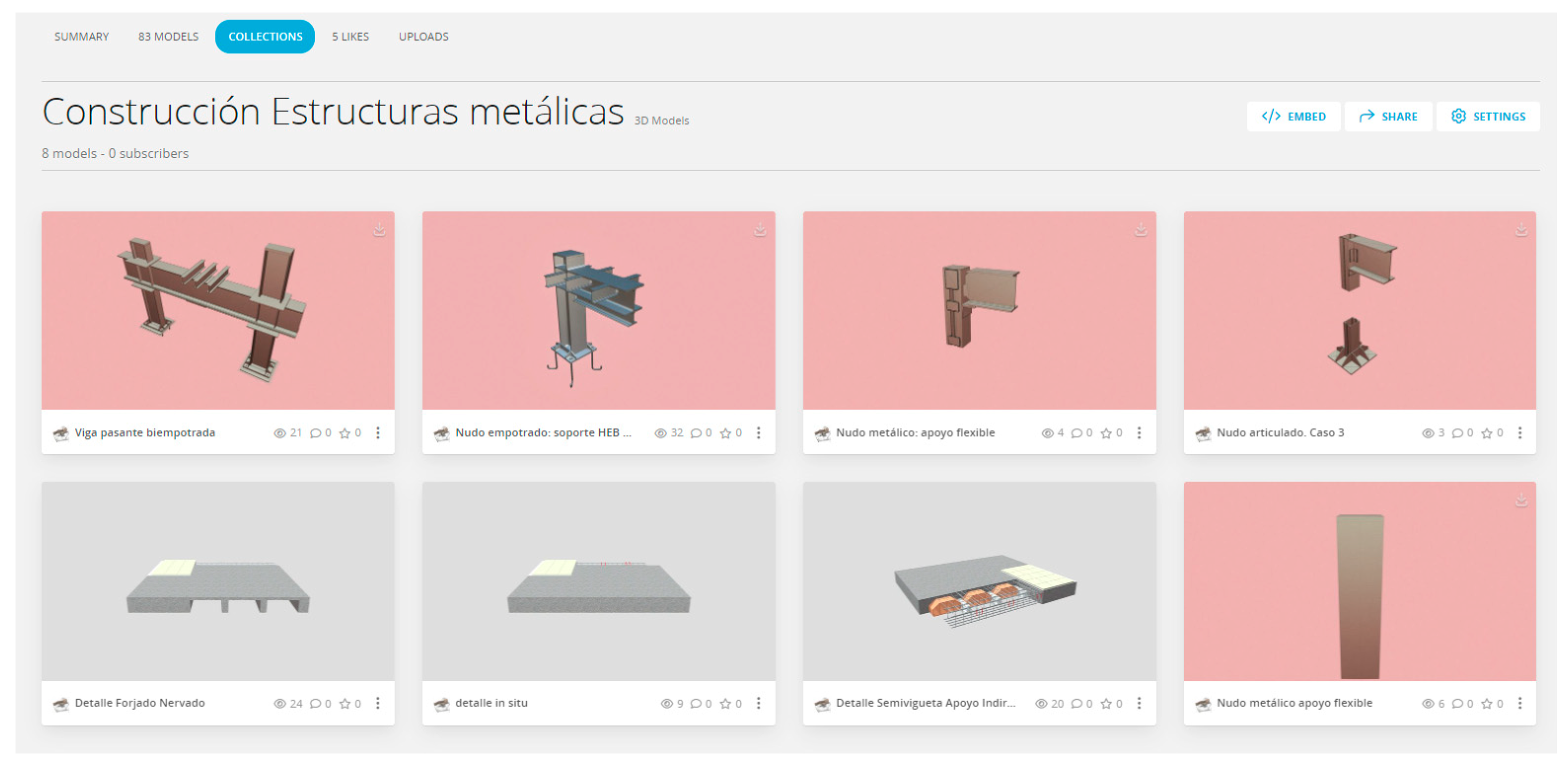
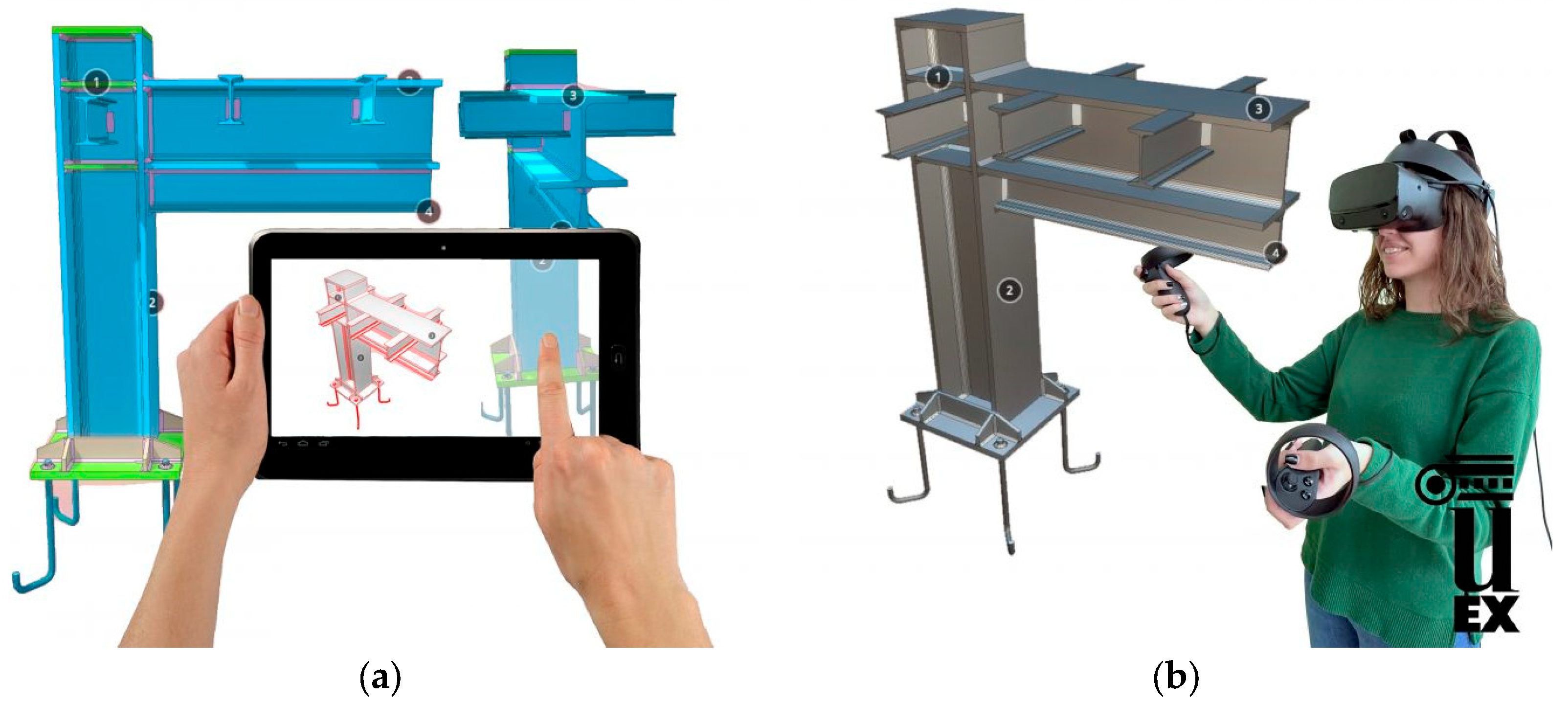
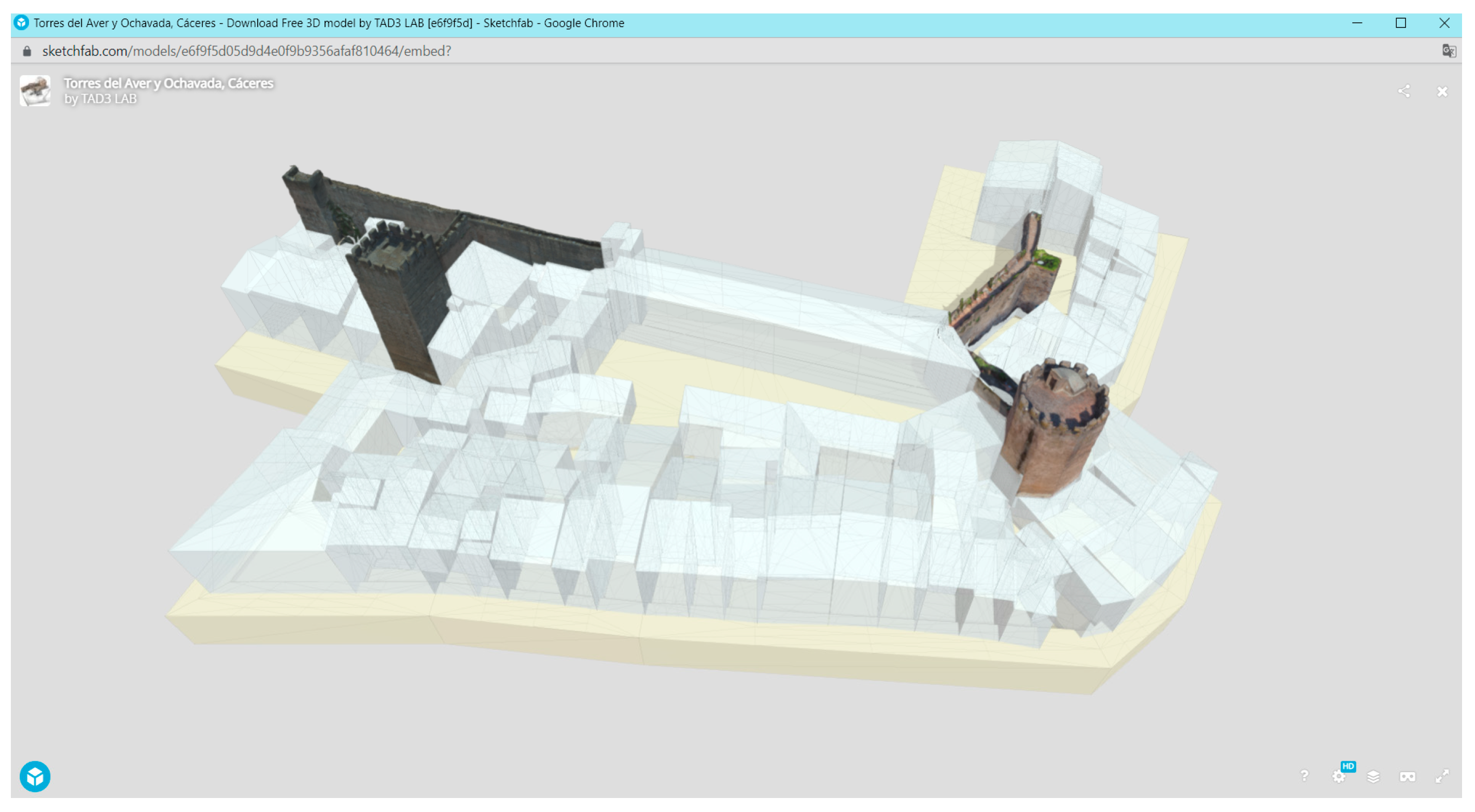

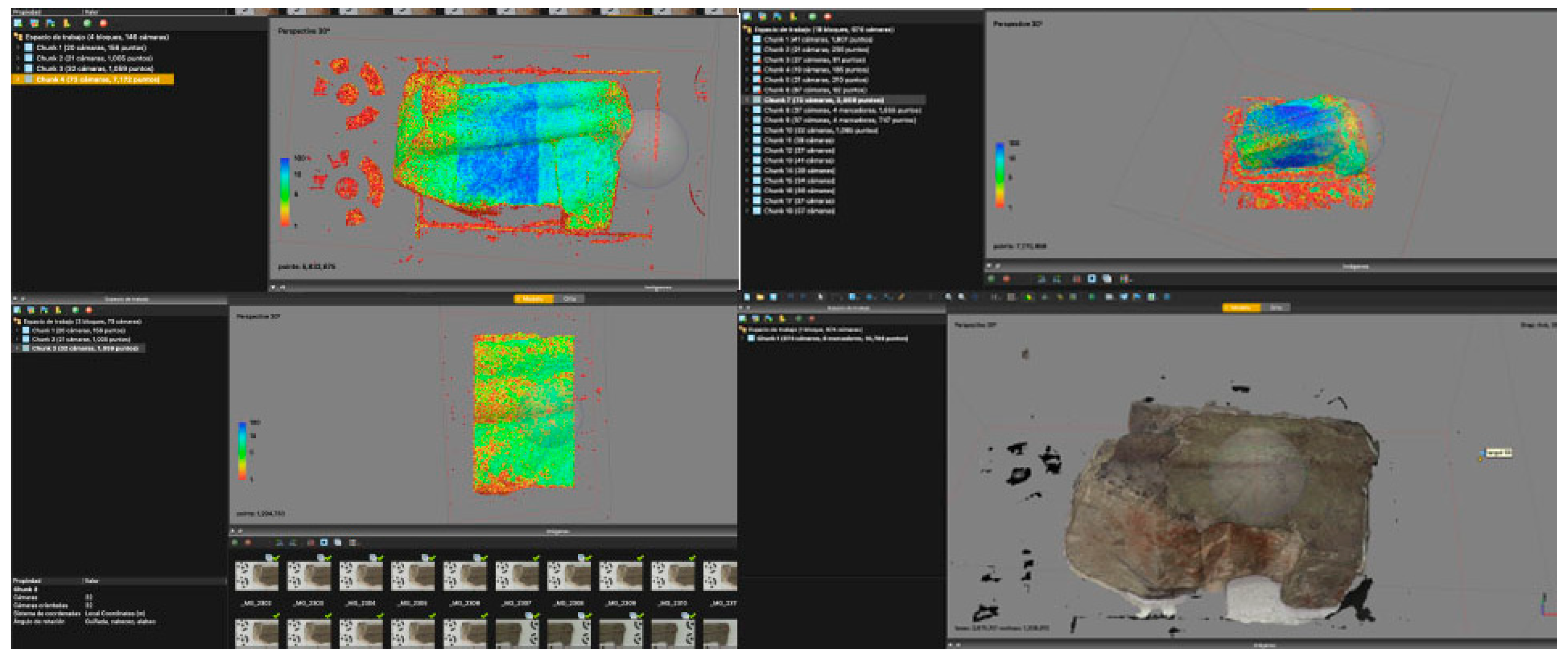

| Camera Parameters | |
|---|---|
| Focal | 11 |
| ISO | 100 |
Disclaimer/Publisher’s Note: The statements, opinions and data contained in all publications are solely those of the individual author(s) and contributor(s) and not of MDPI and/or the editor(s). MDPI and/or the editor(s) disclaim responsibility for any injury to people or property resulting from any ideas, methods, instructions or products referred to in the content. |
© 2023 by the authors. Licensee MDPI, Basel, Switzerland. This article is an open access article distributed under the terms and conditions of the Creative Commons Attribution (CC BY) license (https://creativecommons.org/licenses/by/4.0/).
Share and Cite
Rueda Márquez de la Plata, A.; Cruz Franco, P.A.; Ramos Sánchez, J.A. Applications of Virtual and Augmented Reality Technology to Teaching and Research in Construction and Its Graphic Expression. Sustainability 2023, 15, 9628. https://doi.org/10.3390/su15129628
Rueda Márquez de la Plata A, Cruz Franco PA, Ramos Sánchez JA. Applications of Virtual and Augmented Reality Technology to Teaching and Research in Construction and Its Graphic Expression. Sustainability. 2023; 15(12):9628. https://doi.org/10.3390/su15129628
Chicago/Turabian StyleRueda Márquez de la Plata, Adela, Pablo Alejandro Cruz Franco, and Jorge Alberto Ramos Sánchez. 2023. "Applications of Virtual and Augmented Reality Technology to Teaching and Research in Construction and Its Graphic Expression" Sustainability 15, no. 12: 9628. https://doi.org/10.3390/su15129628
APA StyleRueda Márquez de la Plata, A., Cruz Franco, P. A., & Ramos Sánchez, J. A. (2023). Applications of Virtual and Augmented Reality Technology to Teaching and Research in Construction and Its Graphic Expression. Sustainability, 15(12), 9628. https://doi.org/10.3390/su15129628







